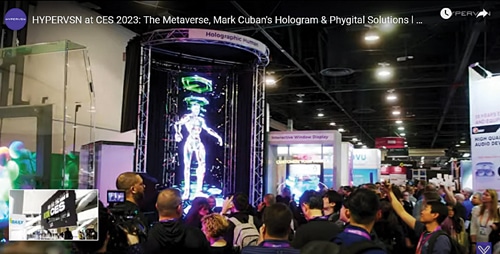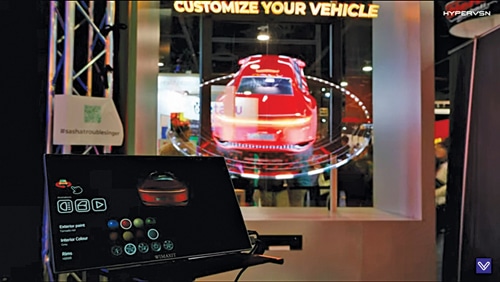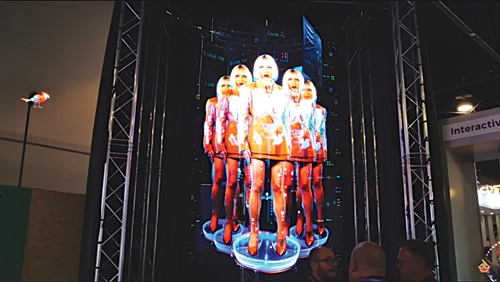This article was first published in EFY Print Magazine April 2023 Issue.
CES 2023 renewed the debate on the future of the metaverse. While the exhibitors were all agog about it, the experts on panels suggested moving ahead with caution
It was evident from the videos that visitors to the Central Hall at CES 2023 were enjoying the immersive treat spread out for them by various metaverse tech companies exhibiting their ware. On the other hand were the expert panels trying to arrive at a reasonable definition for the metaverse, and to figure out how it might really be used and by whom. Together they managed to once again fire the imaginations of those who had almost written off the metaverse as empty hype. And well, we got a great spin for our quarterly update.

What is the metaverse?
Despite everyone talking about it, this question never ceases to exist. Every panel discussion on the metaverse seems to start with how it can be defined. During the “The Road to the Open Metaverse” session at the global technology conference in CES 2023, Neil Trevett, Vice President – Developer Ecosystems, Nvidia, and Chairman of the Metaverse Standards Forum, described the metaverse as a virtual world that combines the connectivity of the Web with the immersivity of spatial computing. “It’s GPUs, it’s extended reality, it’s virtual reality, it’s Web3 and the magic pixie dust—artificial intelligence and machine learning, which makes everything magical… When you put these potentially disruptive technologies together, interesting stuff is going to happen,” he said.
He opined that business leaders should not get carried away by the hype but should nevertheless start preparing for it, because it will gradually creep into our lives. Forrester analyst J.P. Gownder suggested that metaverse technology vendors need to be focused on the nuts and bolts of business fundamentals in 2023. “If they show a flashy demo but do not have any customers? That is a red flag,” he warned! According to him, enterprises might get more tangible benefits from using the metaverse for employee collaboration, training, onboarding, etc.

Edwina Fitzmaurice, a member of the World Economic Forum’s Global Future Council, opined that enterprise interest in digital twins and collaboration might lead to highly-developed hardware. “I think we’re going to see AR glasses come out for the first time in a meaningful way, supported by some really good apps,” she said.
Peggy Johnson, Chief Executive Officer at Magic Leap, an American company that develops augmented reality (AR) headsets, remarked that although there is a growth in the consumer sector, the enterprise market will remain more important to them till the prices of headsets can be brought down.
When fielding questions from the audience about what is blocking the metaverse’s progress, most panellists agreed that one important factor was the absence of ‘Killer Apps’ that encourage take-up of metaverse technology. Other points that came up were the need to work on human-centric experiences, interoperability, privacy, safety and ethics, and so on.
The panellists indicated that we are likely to see some real serious use cases soon, such as on-site use of digital twins for collaboration, design work and customer visualisations; use of AR in operating theatres, giving surgeons three-dimensional (3D) visualisations during medical procedures (Magic Leap recently received the safety certification for use as medical electrical equipment), and so on. In his closing comments, Neil Trevett advised decision makers not to get left behind the metaverse hype cycle, but to be a part of it instead.
There were more such panel discussions and talks dedicated to different aspects of the metaverse, such as the creator economy and non-fungible tokens (NFTs), metaverse and gaming, Web3, challenges and opportunities, and so on. In one such panel discussion, experts opined that it is time to break free from terrifying jargon like non-fungible tokens, and focus on application based terms that are easy on the user too.
For example, many brands prefer to call NFTs as digital collectibles, a term that resonates better with the user. For the metaverse to succeed, companies should focus on user-centric experiences, rather than showing off the technology or terminology.

As Kirthiga Reddy, Co-founder and CEO of Virtualness, a Web3 marketing agency, remarked during another event in February this year, “People do not care about the underlying technology. They care about how to use it. Clients do not care about NFTs, they care that NFTs allow them to have much stronger connections to their customers.” On a similar strain, Cathy Hackl, Chief Metaverse Officer of Web3 consultancy company Journey, remarked in a CES panel discussion that, “Bridging the digital and physical in an unremarkable, everyday kind of way, with unremarkable everyday technology is actually the core [of the metaverse].”
At the event, the Blockchain Association discussed how blockchain technology and cryptocurrency can underpin many of the technological trends forecasted for the year ahead. According to a report released by Accenture at CES 2023, the metaverse industry could potentially be worth as much as US$ 1 trillion by 2025 thanks to growing interest in the metaverse as a tool for creators and as a means of enhancing daily life. The findings indicate that more than half of the 9,000 consumers surveyed see the metaverse as a business opportunity for creating and monetising content.
You can head to CES website and official YouTube channel to check out snapshots of the exhibitions, and discussions that happened in the backdrop of CES 2023, such as how to build a business in the metaverse, bringing a heritage brand into Web3, and more.
Showcased at CES
There were a lot of exciting metaverse-related products on display at CES this year. bHaptics showcased a full body haptic suit, with accessories spanning from head to toe. It lets users feel more than 300 experiences—from handshakes and hugs to raindrops and explosions. They aim to connect people with the digital world in more natural ways.
At CES, Ixana unveiled a new ultra-low-power chip, which is based on a disruptive wireless tech called Wi-R, and provides smart devices with the ability to securely communicate with touch. Wi-R is a ‘wire-like wireless technology’ developed at Purdue University for body area network devices. It uses the electro-quasistatic field around you for private, high-speed, ultra-low energy data transfer.
This combines the security and performance of wires with the convenience of wireless communication. “Compared to Bluetooth, Wi-R offers 100X better energy efficiency,” said Shreyas Sen, Chief Technology Officer of Ixana, in a statement. “Additionally, Wi-R boasts faster data rates, lower latency, and higher reliability with its interference robustness and low bit error rates. Wi-R is confined near the surface, which leads to unique advantages in physical security, multi-node co-existence, touch detection, and communication.”
When using this technology, wearable devices like headsets will not need their own processors or bulky power sources, making them light and comfortable enough to use all day long. “Ixana will do for wearables and the metaverse what Qualcomm did for mobile phones—introduce transformative capabilities with high-speed data and distributed computing, leading to accelerated adoption,” added Angik Sarkar, Chief Executive Officer, Ixana. The evaluation kit is now available for pre-order. Ixana expects this tech to find its way into devices in around 2-3 years.
Magic Leap showcased eight AR solutions built on Magic Leap 2, an immersive enterprise AR device. These included Cisco’s Webex Hologram, an immersive 3D meetings solution; NVIDIA Omniverse, a digital twin solution for industries; Taqtile Manifest, an AR-enabled platform for deskless employees to successfully perform complex operational and maintenance tasks anywhere and at any time; Geopogo, an immersive, multi-user visualisation app that lets users instantly convert their 3D design files into AR models; Avrio, an immersive and customisable AR training software platform for defence and public sector personnel; and Brainlab, which lets medical professionals view diagnostic images in 3D.
Magic Leap Assist lets users share their on-device view of real-world and digital content with experts, to get in-context assistance. Magic Leap Wildfire, which was developed by Magic Leap for the World Economic Forum, is a defence and public sector command and control station demonstration.
HyperVSN’s SmartV holographic solutions also garnered a lot of attention at CES, as no one could ignore a 4.9-metre (16ft) tall holographic human talking or performing in front of them! Using a set-up that included the SmartV Wall, SmartV Digital Avatar, and SmartV 3D Modeller solutions, HyperVSN demonstrated holographic livestreams and futuristic retail solutions.
Their holographic displays work both indoor and outdoor. You can livestream a performance by an actual person. Or, you can create a hologram of a completely artificial intelligence (AI)-driven avatar, say, to respond to customer queries in a retail store.
TCL showcased what it claims to be the world’s first AR glasses. It looked pretty much like normal glasses, and people wearing it seemed to be at ease. The AR glasses can auto-translate when someone speaks to you in a foreign language, it can help with navigation, take pictures, and play music, among other things. TCL said the glasses will first be available to the developer community, before it is ready for the public.
Companies like Brelyon and 3D Game Market showcased headset-free virtual monitors or 3D screens, which let you experience immersive content without wearing any cumbersome glasses; while HTC showcased a high-end VR headset to compete with Meta’s. OVR unveiled a headset with an aroma cartridge that has eight aromas, which can be combined with each other to create many more aromas. This adds a sense of smell to the immersive VR experience. They said the headsets will be available in the market later this year.

Samsung and LG showcased smart televisions with blockchain integrations, such as NFT wallets and marketplaces. Unstoppable Domains, a San Francisco based company building domains on blockchains, demonstrated crypto wallets, blockchain domains, and other such offerings that it said were the gateway into Web3. For enterprises, there were some awesome productivity-oriented metaverse tools from players like FORUM8 and Dentsu NXT Space.
All in all, a very interesting year for metaverse enthusiasts at CES!
Metaverse news, from the tech world
Last month, Meta organised a Zoom call with ad agencies to help them understand the concept of the metaverse. They spoke about the concept of mixed reality (MR), a merging of the virtual and physical worlds, wherein a person wearing an MR headset can trigger a virtual world reaction using a real-world object. Meta told advertisers that MR could start to become a reality for consumers in a few years. Right now, MR headsets are too expensive for people to indulge in.
Indian-American Neal Mohan recently took over as YouTube’s CEO. Last year, as the company’s Chief Product Officer, he chalked out plans to integrate metaverse based content experiences and content tokenisation via NFTs, thereby giving creators more ways to engage with fans and monetise their content. Mohan is still very optimistic about the metaverse, and with him at the helm, metaverse trend watchers feel these plans might be realised faster.
And, of course, everyone is talking about how AI is going to help create the metaverse faster, and how it is going to make it more effective. A TIME magazine author who was researching on this, wrote to Sean Ellul, Co-founder of Metaverse Architects. He got a well-written five-paragraph email response giving almost every detail he needed.
But, wait! In the fourth paragraph, the email revealed that it had been written by ChatGPT itself. It had responded to Ellul’s simple prompt: “Write an email to Andrew, from TIME, about how at the company Metaverse Architects we are using ChatGPT to brainstorm code, prepare articles, and ideate new projects. We even use it to write emails, such as this one!” Indeed, AI tools like ChatGPT are likely to make interactions much more natural and informative in the metaverse.
On the other hand, AI systems like DALL-E, Midjourney, Magic3D, and DreamFusion—which can create realistic images and art from a description in natural language—will make the creation of the metaverse incredibly fast. Imagine how easy it would be if users just wrote a paragraph or verbally discussed their ideas about a virtual space and it was created instantly by AI tools. This would not only speed up the creation of the metaverse but also let users create their spaces the way they want them to be, without having any technical knowledge.
“We’re able to fill the Internet with interesting stuff because everybody is capable of taking a picture, recording a video, or writing words,” said Rev Lebaredian, Vice President for Omniverse and Simulation Technology at Nvidia, to TIME magazine. “If we are going to create a 3D Internet, then you absolutely have to have the people who are participating in it creating content as well—and the only hope we have of making that happen is if AI can help us.”
And beyond
Everyone is trying to keep abreast of what the tech majors like Nvidia, Meta, and Microsoft are doing about the metaverse. But to understand the future of the technology, we should perhaps stop and look outside the tech world, at how everyone else is preparing for it.
According to a report in The Guardian, McDonald’s recently filed ten trademark applications, including one for a virtual restaurant. Also, Walmart, Samsung, and PricewaterhouseCoopers are moving ahead with plans to operate in the metaverse.
There is excitement in the football world too, as English Premier League champions Manchester City recently partnered with Sony to develop digital fan experiences. According to the announcement, “The aim of this collaboration is to create a global online fan community where fans can interact with the club and each other within an online ‘metaverse’ which will be a virtual recreation of the Etihad Stadium.” They might even be able to watch matches in the metaverse.
According to Interpol’s recent Global Crime Trend report, cybercrimes are one of the world’s leading crime threats, and are projected to increase more than other crimes in future. The report says that crime has increasingly moved online as the pace of digitalisation has increased. “Criminals are sophisticated and professional in very quickly adapting to any new technological tool that is available to commit crime,” Interpol Secretary-General Jürgen Stock told the BBC in a recent interview. Not to be left in the dark, Interpol is increasingly using its metaverse, which it launched last October, to help officers understand the nature of crimes in the virtual world and how they can tackle these.
The Hermès Handbag Case, which sounds so much like the title of a Hercule Poirot mystery, is one that mightily interested policy makers in recent times. Luxury goods brand Hermès sued Mason Rothschild for creating NFTs called MetaBirkins using virtual furry interpretations of their Birkin series of handbags, without their permission. They argued that people would think the NFTs were affiliated with the brand. “I’m not creating or selling fake Birkin bags. I’m creating art works that depict imaginary, fur-covered Birkin bags. The fact that I sell the art using NFTs doesn’t change the fact that it’s art,” argued Rothschild, adding that he had put in required disclaimers about not being associated with the brand.

However, as explained in a World Economic Forum report, “Many fashion brands are showing interest in the metaverse, where they could sell digital clothing and accessories for avatars. Having the ability to control their designs and brands, and to enforce their intellectual property, will be critical to how profitable the metaverse could prove for them.” In February this year, the jury ordered Rothschild to pay US$133,000 in damages to Hermès, determining that he did, in fact, profit off Hermès’ goodwill by producing NFTs based on the design house’s Birkin bags. This case has set a precedent as to how trademark laws are likely to be applied to digital assets.
There is invariably a lot of stuff going on related to the metaverse—in and outside the tech world. According to a Gartner strategic planning assumption, by 2027 over 40% of large organisations worldwide will be using a combination of Web3, spatial computing, and digital twins in metaverse based projects aimed at increasing revenue. “The metaverse seems more hype than reality right now, so now is exactly the time to start to take advantage of it,” says Gartner, on their website.
Right now, the metaverse is something that you cannot ignore. At the same time, experts suggest moving with caution, because it is still not clear which metaverse-specific technologies and investments will have long-term impact and returns.
Janani G. Vikram is a freelance writer based in Chennai, who loves to write on emerging technologies and Indian culture. She believes in relishing every moment of life, as happy memories are the best savings for the future








